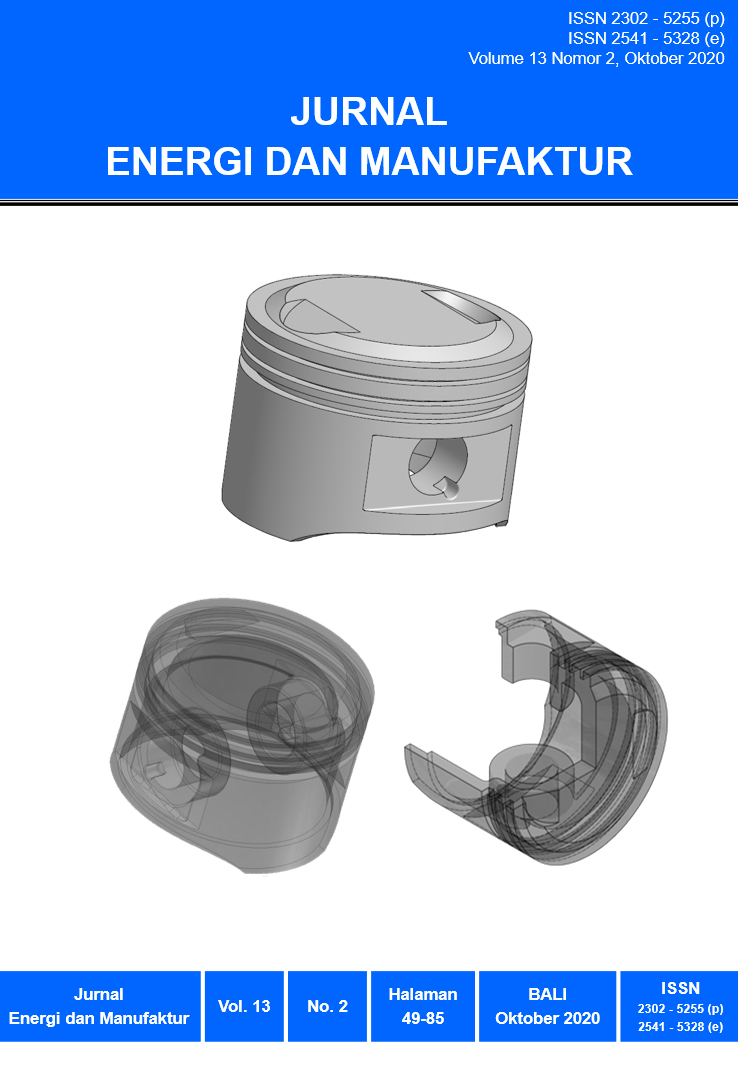Peningkatan Efisiensi Distilasi Air Energi Surya Menggunakan Pengapung
Abstract
The joint for two different materials (AA5052 and AA6061) can be done by the Dissimilar Friction Stir Welding (DFSW) process. Therefore, this study was conducted to analyze the mechanical properties of dissimilar welding joints. In this study the DFSW process uses a tool with a shoulder Ø 17.8 mm and a cylindrical pin Ø 5 mm. FSW blocking is done on conventional milling machines with 1300 rpm, 1950 rpm and 2850 rpm tool rotation variations, while the welding speed variations are 43 mm / min, 130 mm / min and 240 mm / min. The results of mechanical properties testing showed the highest hardness value obtained was 55.3 HBN at 1300 rpm with 240 mm / min feeding, the highest tensile strength occurred for 1300 rpm and 240 mm / min feeding at 123.51 MPa. The fracture of the tensile test results generally occurs in the HAZ area and the AA5052 base metal Nugget. Investigation results show that the DFSW connection of aluminum alloy material AA 6061 and AA 5052 adapt is well connected, but in terms of general strength the tensile strength of the joint (HAZ and Nugget) is smaller than the tensile strength of the base metal. This DFSW connection adaptation is applied to connections that do not accept load or tensile strength due to the load received by the connection not to exceed the maximum tensile strength of base metal AA 5052
Downloads
References
[2] A. E. Kabeel, S. A. El-Agouz, R. Sathyamurthy, and T. Arunkumar, “Augmenting the productivity of solar still using jute cloth knitted with sand heat energy storage,” Desalination, vol. 443, no. May, pp. 122–129, 2018, doi: 10.1016/j.desal.2018.05.026.
[3] W. M. Alaian, E. A. Elnegiry, and A. M. Hamed, “Experimental investigation on the performance of solar still augmented with pin-finned wick,” Desalination, vol. 379, pp. 10–15, 2016, doi: 10.1016/j.desal.2015.10.010.
[4] K. Kalidasa Murugavel and K. Srithar, “Performance study on basin type double slope solar still with different wick materials and minimum mass of water,” Renew. Energy, vol. 36, no. 2, pp. 612–620, 2011, doi: 10.1016/j.renene.2010.08.009.
[5] D. Das, U. Bordoloi, P. Kalita, R. F. Boehm, and A. D. Kamble, “Solar still distillate enhancement techniques and recent developments,” Groundw. Sustain. Dev., vol. 10, no. February, p. 100360, 2020, doi: 10.1016/j.gsd.2020.100360.
[6] N. P.K. et al., “Analysis of an inclined solar still with baffles for improving the yield of fresh water,” Process Saf. Environ. Prot., vol. 105, pp. 326–337, 2017, doi: 10.1016/j.psep.2016.11.018.
[7] H. Sharon, K. S. Reddy, D. Krithika, and L. Philip, “Experimental performance investigation of tilted solar still with basin and wick for distillate quality and enviro-economic aspects,” Desalination, vol. 410, pp. 30–54, 2017, doi: 10.1016/j.desal.2017.01.035.
[8] R. S. Hansen, C. S. Narayanan, and K. K. Murugavel, “Performance analysis on inclined solar still with different new wick materials and wire mesh,” Desalination, vol. 358, pp. 1–8, 2015, doi: 10.1016/j.desal.2014.12.006.
[9] A. E. Kabeel, Y. Taamneh, R. Sathyamurthy, P. Naveen Kumar, A. M. Manokar, and T. Arunkumar, “Experimental study on conventional solar still integrated with inclined solar still under different water depth,” Heat Transf. - Asian Res., vol. 48, no. 1, pp. 100–114, 2019, doi: 10.1002/htj.21370.
[10] R. Samuel Hansen and K. Kalidasa Murugavel, “Enhancement of integrated solar still using different new absorber configurations: An experimental approach,” Desalination, vol. 422, no. April, pp. 59–67, 2017, doi: 10.1016/j.desal.2017.08.015.

This work is licensed under a Creative Commons Attribution-NonCommercial-ShareAlike 4.0 International License.









